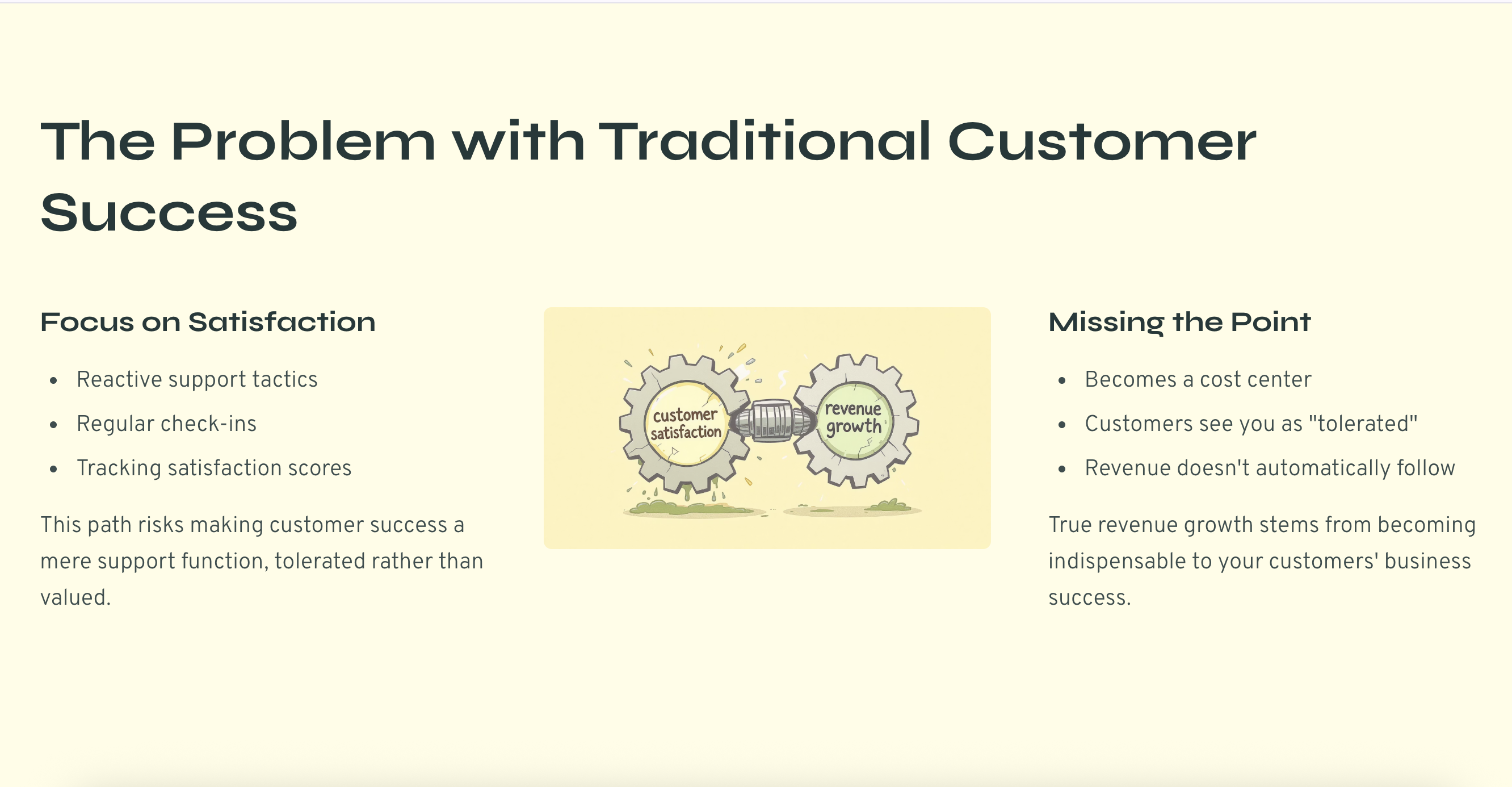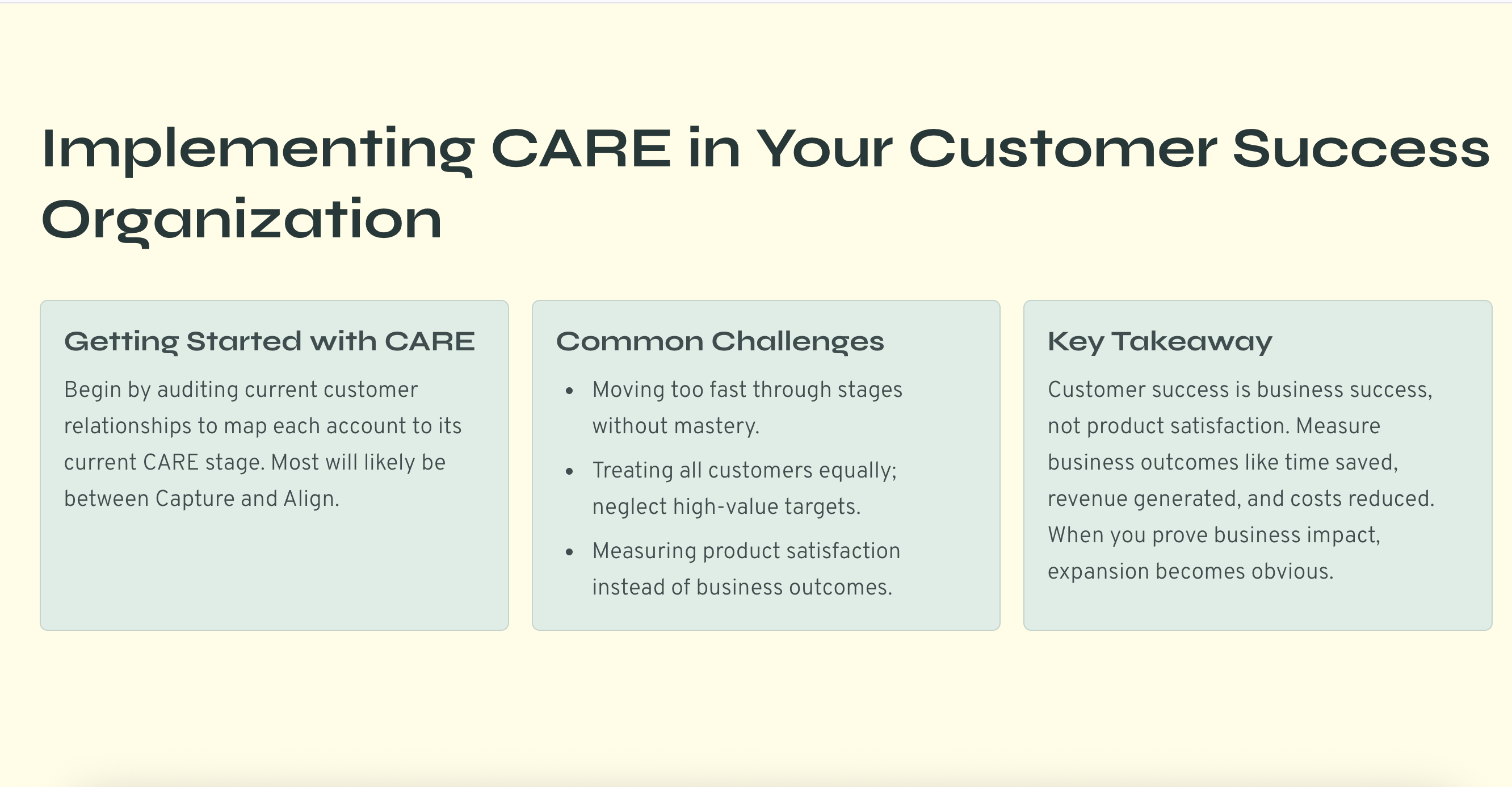Customer Success Framework: How CS Teams Drive Growth with the CARE Method
Article written by
Neetasha Patnaik

INSIDE THE ARTICLE
SHARE THIS ARTICLE
Summary
Most CS teams stay busy keeping customers satisfied but never drive real revenue because they’re solving the wrong problem. The CARE Framework—Capture, Align, Reinforce, Elevate—shifts the focus to business outcomes, not check-ins or ticket counts. This blog breaks down how top CS teams use CARE to improve retention, spark expansions, and turn successful customers into advocates.
I learned something surprising when I analyzed why some customer success teams drive massive revenue growth while others barely move the needle.
"We're hitting our satisfaction scores," one CS leader told me during a strategy session. "But our expansion revenue is flat. I don't understand why happy customers aren't buying more."
That conversation made me realize most CS teams are solving the wrong problem. They focus on keeping customers happy instead of making them successful. There's a big difference.
After studying how the best revenue-generating CS teams actually work, I found they follow four specific stages. I call it the CARE Customer Success Framework.
The Problem with Traditional Customer Success Framework
Most CS advice focuses on support tactics: "Be responsive," "Send regular check-ins," "Track satisfaction scores."
All this assumes the same thing: keep customers happy, and revenue will follow. But this approach misses the point. When you focus only on satisfaction, you become a cost center that customers tolerate.
Real revenue growth happens when you become essential to their business success. You have to prove value at each stage, or customers will see you as just another vendor.

The CARE Framework for Customer Success Revenue Growth
To turn customer success into a true revenue driver, you need a framework that goes beyond check-ins and satisfaction scores. That’s exactly what CARE delivers.
C – Capture Context: Get the Full Picture of What Success Looks Like
This isn't about product features. It's about understanding their business goals, who makes decisions, and how they measure success.
I've seen CS teams assume they knew what customers wanted based on the sales handoff. Six months later, those customers churned because we were solving the wrong problems.
The best CS teams spend their first 30 days learning the customer's business as deeply as their own product. This discovery phase is foundational to any effective customer success framework, as it ensures you're solving for real business needs—not just technical fit.
The test: Can you explain their business challenges without mentioning your product? If not, dig deeper.
A – Align Solutions: Connect Your Product to Their Specific Business Outcomes
Once you understand their goals, show exactly how your product helps them win. This isn't about feature demos. It's about business impact.
One of our enterprise customers was struggling with manual reporting that took their team 8 hours per week. Instead of showing them all our reporting features, we focused on one: automated dashboards that would save those 8 hours.
Result: They saw immediate value and expanded their usage within 60 days.
The test: Can the customer clearly explain how your product makes their job easier or their business better?
R – Reinforce Value: Continuously Prove You're Worth Keeping and Expanding
After onboarding, most CS teams go quiet. This is exactly when you should be most active. Your customers are forming opinions about whether your product actually delivers on its promises.
Use their usage data to show concrete business results. Run quarterly business reviews that connect product usage to their original goals. Keep evolving your approach as their needs change.
We started tracking how our customers' key metrics improved after using our product. When we shared these insights during reviews, expansion conversations became natural. This stage is often where a strong customer success framework begins to show its impact.
The test: Can you show specific business improvements that happened because of your product?
E – Elevate to Advocacy: Turn Successful Customers into Your Growth Engine
Satisfied customers might renew. Successful customers become advocates who drive new business.
When customers achieve real success with your product, they want to share it. Feature them in case studies. Invite them to speak at events. Ask for referrals to similar companies.
I've seen one happy customer generate 5 new deals through referrals and case study impact. That's more valuable than any marketing campaign.
The test: Are your best customers actively recommending you to others?

One Insight That Accelerates Customer Success Revenue
Here's the most important lesson: Customer success is business success, not product satisfaction.
The biggest mistake CS teams make is measuring the wrong things. They track product usage, support tickets, and satisfaction scores. These don't predict revenue.
Smart CS teams measure business outcomes: time saved, revenue generated, costs reduced. When you prove business impact, expansion becomes obvious.
Why One CS Approach Doesn’t Fit Every Customer?
Here's something that's often overlooked in CS playbooks: The same strategy doesn't work with every customer.
You have to:
- Identify the right accounts to invest deeply in
- Engage the right stakeholders who influence renewals, uncover new use cases, and control the budget
- Understand the pace and depth each customer needs to succeed
Not every customer wants (or is ready for) advocacy. Not all will expand. That's okay — but you need to know who's worth the deeper play. This is where a flexible customer success framework becomes crucial, especially when navigating varying levels of readiness and opportunity.
What Should You Do Right Now to Apply the CARE Framework?
The CARE framework isn't a timeline. It's a way to check where your customers are and what they need next.
For each customer, ask:
- Capture: Do I understand their real business goals?
- Align: Can they see clear value from our product?
- Reinforce: Am I proving ongoing business impact?
- Elevate: Are they ready to become advocates?
Focus completely on the stage where they are before moving to the next.
How Does Each Stage of CARE Drive Revenue?
Most CS teams try to do everything at once. They want advocacy-level relationships while still figuring out basic value alignment.
But sustainable revenue growth doesn't work that way. Each stage builds the foundation for the next.
The CS teams that drive real revenue don't just keep customers. They make customers successful enough to buy more, refer others, and become case studies.
What stage describes most of your customer relationships right now? And what would change if you focused completely on mastering that stage before trying to advance?
The answer determines whether your CS team becomes a revenue engine or stays a support function. This approach is central to any customer success framework built for scale.
Implementing CARE in Your Customer Success Organization
Putting CARE into action isn’t about adding more meetings or more dashboards. It’s about reshaping how your team understands customers, measures success, and prioritizes time. Start by mapping every account to its current CARE stage—you’ll quickly notice most customers sit between Capture and Align, which is exactly where revenue stalls if left unchecked.
Once you know the baseline, roll out CARE in three steps:
1. Build Stage Awareness Across the Team
Train your CS managers to diagnose which stage a customer is in based on conversations, usage patterns, and stakeholder behavior. CARE works only when the whole team speaks the same language.
2. Operationalize Stage-Specific Playbooks
Each stage needs its own rituals:
- Capture: 30-day discovery plan, stakeholder mapping, goal documentation
- Align: value narratives, outcome-focused demos, ROI baselines
- Reinforce: quarterly business reviews, outcome dashboards, usage insights
- Elevate: case studies, referral asks, advocacy touchpoints
Make these playbooks lightweight and repeatable—not another overwhelming checklist.
3. Track the Metrics That Actually Matter
Move away from “Are they happy?” and toward “Are we driving outcomes?”
Monitor:
- Stage progression speed
- Documented business results
- Expansion revenue linked to Reinforce and Elevate stages
- Customer advocacy actions (reviews, referrals, case studies)
When implemented cleanly, CARE turns CS from a reactive support function into a forward-moving revenue engine—one where every customer conversation has purpose, every stage builds toward value, and expansion becomes the natural outcome of success, not a forced negotiation.

As you roll out CARE, certain patterns tend to trip teams up. Let’s break down the common challenges so you can avoid them from day one.
Common Challenges in Building a Customer Success Revenue Framework
The most common challenges in building a customer success revenue framework include:
Moving too fast through stages: Each stage requires mastery before advancement. Pushing for advocacy before proving value creates awkward conversations.
Focusing on all customers equally: Not every account deserves the same investment. Identify your high-value targets for deeper engagement.
Measuring the wrong metrics: Stop obsessing over satisfaction scores. Start tracking business outcomes.
These challenges don’t disappear overnight, but they become manageable the moment you spot them early. Fixing just one of them can dramatically shift your CS team from reactive to revenue-driving.
CARE Framework Quick Reference
Before you put CARE into practice, here’s a quick snapshot of what each stage looks like and how to know you’re doing it right. Use this as your at-a-glance guide while working through accounts.
Stage 1 - Capture Context
- Duration: First 30 days
- Key Activity: Deep business discovery
- Success Metric: Can explain their challenges without product mentions
Stage 2 - Align Solutions
- Duration: Days 30-90
- Key Activity: Connect features to business outcomes
- Success Metric: Customer articulates product value clearly
Stage 3 - Reinforce Value
- Duration: Ongoing after initial success
- Key Activity: Quarterly business reviews with outcome data
- Success Metric: Documented business improvements
Stage 4 - Elevate to Advocacy
- Duration: After proven success
- Key Activity: Case studies and referral programs
- Success Metric: Active customer recommendations
Conclusion
At the end of the day, revenue doesn’t come from happy customers—it comes from successful ones. When your team deeply understands customer goals, aligns your product to real outcomes, reinforces those results with data, and elevates the right accounts into advocacy, you stop being a “support function” and become a growth driver.
CARE isn’t a linear checklist; it’s a lens that shows you exactly where each customer stands and what they need next. Teams that adopt this discipline grow faster, expand more accounts, and build a healthier, more predictable business. The question now is simple: which CARE stage do most of your customers sit in today—and what’s the one action you can take this week to move them forward?
What Do CS Teams Ask Most About CARE (FAQs)?
What metrics should CS teams track when using CARE?
Track business outcomes: time saved, revenue generated, costs reduced. Also monitor stage progression rates and expansion revenue from accounts at each stage.
How do we handle customers who resist moving to the next stage?
Some customers are content to stay at certain stages. That's fine - force-fitting them into advocacy when they just want basic support damages relationships.
Can one CS manager handle all four CARE stages?
In smaller organizations, yes. Larger teams might specialize by stage, with handoffs as customers progress. Both models work if executed well.
What's the biggest mistake when implementing CARE?
Trying to do all stages simultaneously. Master each stage with a customer before advancing. Foundation-building takes patience but drives lasting revenue.
How does CARE integrate with existing CS tools and processes?
CARE is a strategic customer success framework, not a tool replacement. Use your existing platforms to track stage progression and business outcomes rather than just usage metrics.
Ready to see how AI can transform your RFP process?
With 13 years of global customer success leadership across India, Singapore and Australia, Neetasha Patnaik has built high-performing teams and driven sustainable customer growth for global SaaS companies. As a multilingual leader fluent in 5 languages, she brings unique insights from diverse markets. Certified in ITIL, ITSM, and Project Management, she's recognised as both a Customer Success Champion and Retention Champion.